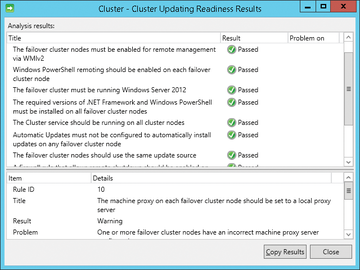« Previous 1 2 3 4
Clusters with Windows Server 2012 R2
Strong Together
Example of a Test Environment
To use a virtual cluster as a file server, for example, and store the data of the virtual file server cluster in shared VHDX files, you need to create a normal cluster as described. For a test environment, the cluster can consist of just a single server.
To store the shared VHDX disks on a particular drive, type the following command at the command line:
FLTMC.EXE attach svhdxflt drive
Then, you can add virtual disks to the individual virtual servers in the cluster and configure them as shared VHDX. After doing so, create the virtual cluster just like a physical cluster.
If you create more shared disks, you can group them together in this way to create a storage pool that can also be used in the cluster. You create the pool in the Storage | Pools section.
Cluster-Aware Updating
In Windows Server 2012, Microsoft introduced the concept of Cluster-Aware Updating (CAU), which allows the installation of software updates via the cluster service. This means that operating system and server applications can be updated without the cluster services failing.
When configuring CAU, you need to create a new role that can perform software updates completely independently in the future. This role also handles the configuration of the maintenance mode on the cluster nodes; it can restart cluster nodes, move cluster roles back to the correct cluster nodes, and much more. You can start the update manually and define a schedule for updates.
To create CAU for a new cluster, first create a new computer object in the Active Directory Users and Computers
snap-in. This procedure is optional, because the CAU wizard can also create the computer object itself. This computer object represents the basis for the cluster role for setting up automatic updates. You don't need to configure the settings for the object – just create it. You can name it after the cluster, adding the extension CAU (e.g., cluster-cau).
Additionally, you should create an inbound firewall rule on all cluster nodes that participate in CAU and select Predefined | Remote Shutdown
as the rule type. The management console is started by typing wf.msc. If the rule already exists, select it from the context menu.
Once done, search for the Cluster-Aware Update setup program on the home screen and start the tool. In the first step, connect to the cluster for which you want to enable CAU. Then, click on the link Analyze cluster updating readiness . The wizard checks to see if you can enable CAU in the cluster (Figure 9).
 Figure 9: Before enabling Cluster-Aware Update, you need to analyze the cluster. Everything looks good in this case.
Figure 9: Before enabling Cluster-Aware Update, you need to analyze the cluster. Everything looks good in this case.
Once you have connected to the desired cluster and carried out the analysis, you can start the setup by running the wizard. You launch it as Configure cluster self-updating options . On the first page, you will see some information about what the wizard configures. On the next page, select Add the CAU clustered role, with self-updating mode enabled, to this cluster . Then, enable the option I have a prestaged computer object for the CAU clustered role and enter the name of the computer object in the box. The wizard can also automatically create the object, which simplifies the configuration in a test environment.
On the next page, you need to specify the schedule that the cluster and each node follow for automatic updates. In the Advanced Options , you can configure some additional settings, but these are optional. For example, the option specifying that the update only launches if all cluster nodes are accessible makes a lot of sense. To do this, set the option RequireAllNodesOnline option to True . Other options include defining scripts to run before or after updating the cluster service.
On the next page, you can specify how the cluster service should deal with the recommended updates and whether these play the same role as critical updates. You then see a summary, and the service is created. If an error occurs, check the computer object's rights for the cluster upgrade. In the object's properties, give the cluster account full access to the new account. Alternatively, you can let the wizard create the computer object. After setting up CAU, run the analysis again.
Patch Management
You can decide which patches the service installs by releasing patches to a WSUS server or enabling local update management on the server. You can view the list of patches to be installed by the service in the CAU management tool by clicking Preview updates for this cluster .
To start the update immediately, click Apply updates to this cluster . You can view the status of the current installations in the CAU management tool, which you used to set up the service. During an update, the corresponding node is switched to maintenance mode. The cluster resources, such as the VMs, are moved to other nodes, then the update is started; finally, the resources are transferred back, then the next node is updated. The CAU FAQ [2] provides more descriptions of this service.
Infos
- VHDX overview: http://technet.microsoft.com/en-us/library/hh831446.aspx
- Cluster-Aware Update: Frequently Asked Questions: http://technet.microsoft.com/en-us/library/hh831367.aspx
« Previous 1 2 3 4
Buy ADMIN Magazine
Subscribe to our ADMIN Newsletters
Subscribe to our Linux Newsletters
Find Linux and Open Source Jobs
Most Popular
Support Our Work
ADMIN content is made possible with support from readers like you. Please consider contributing when you've found an article to be beneficial.







